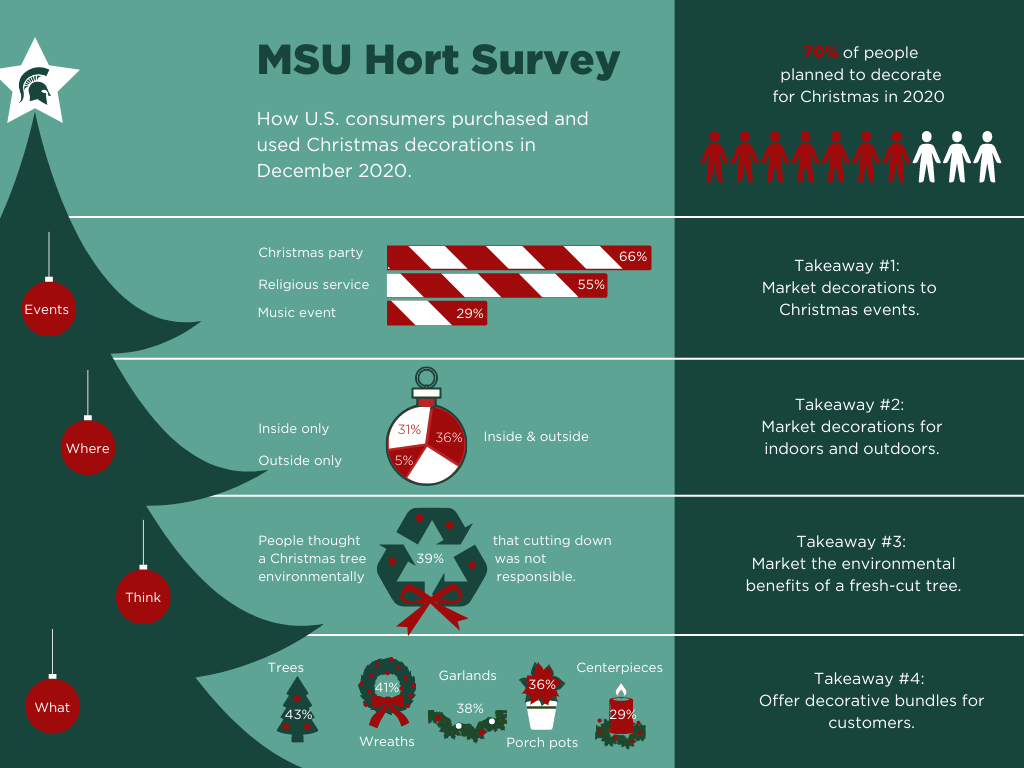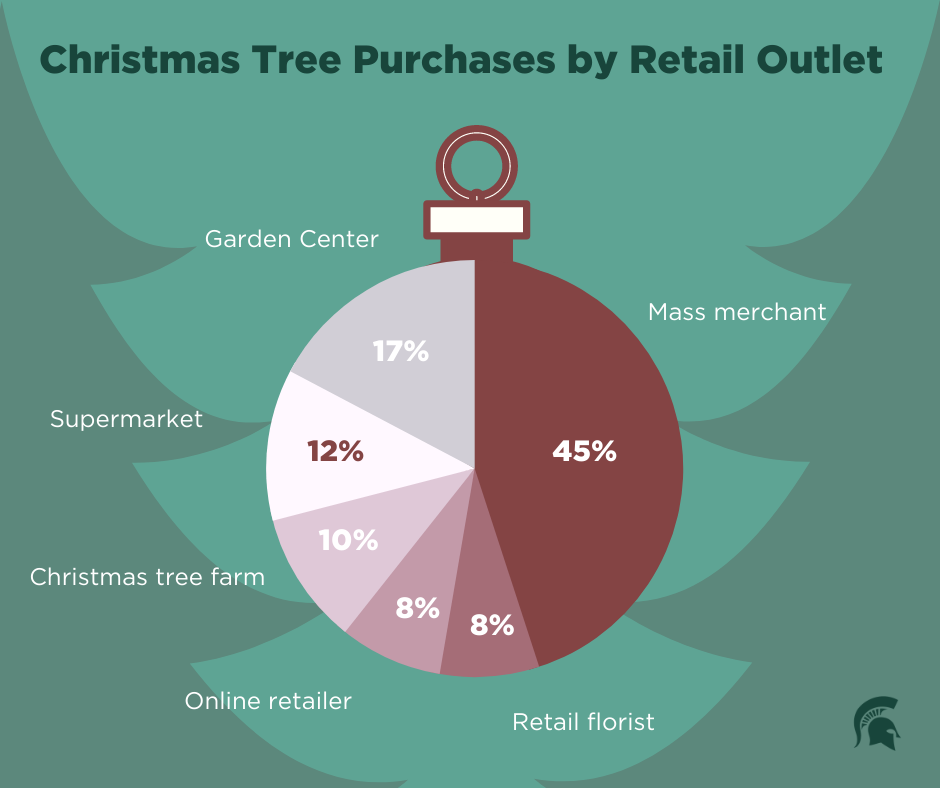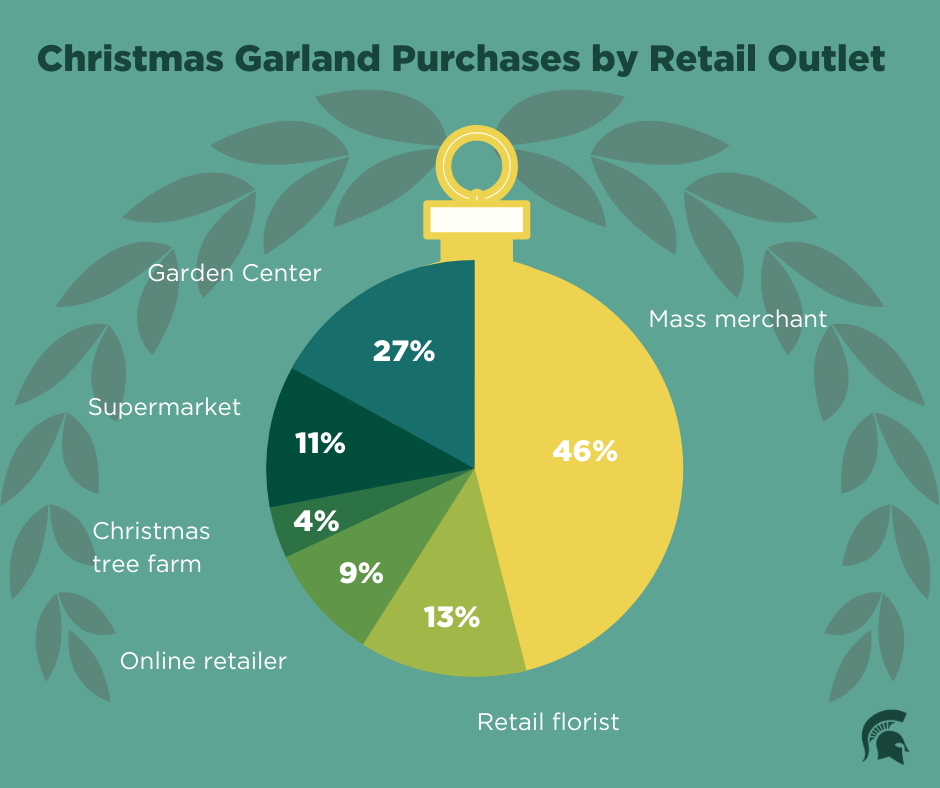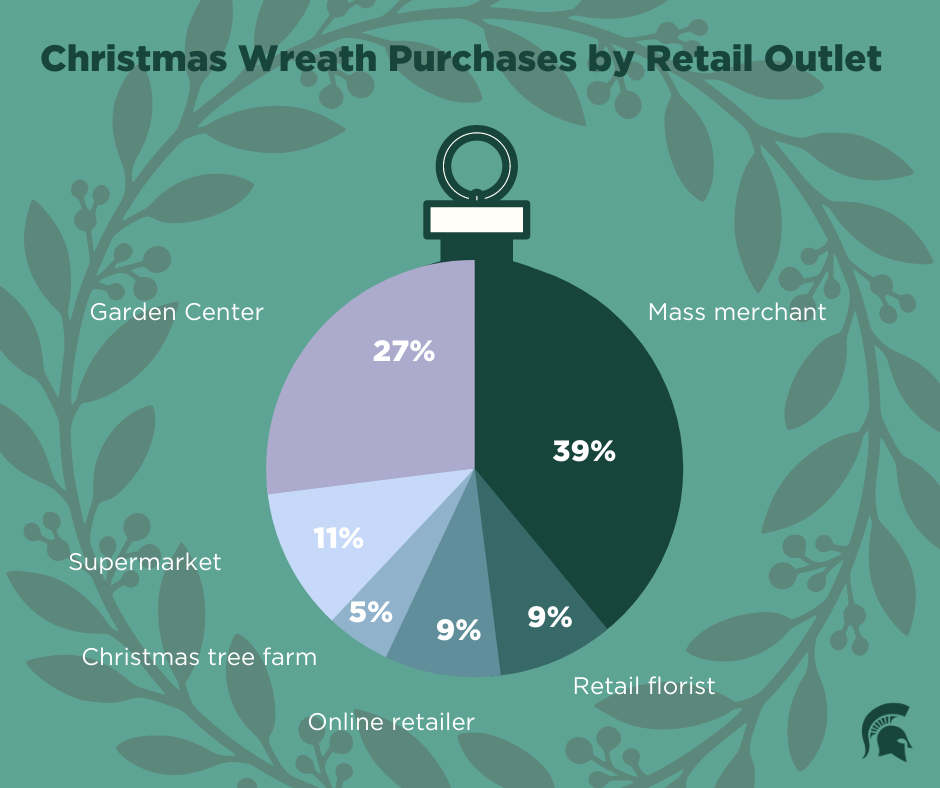
The 2020 Christmas season was unlike any other. COVID-19 protocols such as social distancing, work-from-home protocols, and travel restrictions collided with warm memories of family, friends, food, fun, and festivities throughout the holiday season. Because of this unique Christmas tree shopping environment, we took the opportunity to delve into how U.S. consumers were confronting the holiday season with in order to glean some information about how their purchasing choices might look in the future. This article describes some of our findings.

Who responded to the survey? We contracted with Qualtrics to obtain a representative sample of U.S. households from November 18-30, 2020. Of the 2,173 collected responses, 1,350 completed the survey entirely. Overall, the sample was representative of the U.S. population on average, similar to what might be found in the U.S. Census with 51% identifying as female. Average age was 45-54 years old (18% of respondents and median age category), yet 29% fell into the 25-34 year old category and 18% were in the 55-64 year old category. They were distributed among the Midwest (20%), Northeast (20%), South (38%), and West (21.8%). Only 4% of the respondents were from Michigan, though the data from Michigan respondents was not substantially different from the responses of the rest of the Untied States. Respondents indicated that their average household income was between $60,000 and $79,999. Of all the responses, 70% identified as Caucasian/white, 14% as Black/African-American, 5% Hispanic, and 6% Asian. While 18% had completed a 4-year college degree, 50% had achieved less than that level of education. Nearly 28% had children ages 17 years or under in their home.
How did respondents celebrate Christmas? We asked the survey respondents about some family traditions, celebrations, and events attended during the Christmas season. The first tradition was how long had they been purchasing a tree from a farm? Of the 245 responses to the question, 42% had been purchasing a tree from a farm for 10 years or more yet only 9% had made their tree purchase from a farm for the very first time. Nearly one third had not attended a Christmas party in 2019, one-third attended one party, and the remainder attended two or more parties. Forty-five percent did not attend a Christmas religious services while 31% attended one with the remainder participating in two or more. Three-fourths had not attended a Christmas musical events but 15% attended one and the rest attended two or more.
Take-Home Message #1: Remind them about decoration opportunities outside the home. Places where events are hosted need to be decorated, too. If your customers attend these events, some may help in the planning. Is there a way to remind them on social media or through direct mail pieces that you have items for Christmas decorations for those events, too?
How did respondents plan to decorate for the Christmas 2020 holiday? Our survey suggests that only seven in ten planned on decorating for the 2020 Christmas holiday – fewer than the 77% who reported decorating for Christmas in 2019. Of these households, 36% decorated both inside and outside their home, 31.0% decorated inside only, and 5% decorated outside only (28% did not respond). As expected, most households reported decorating themselves with only 1% hiring help and not decorating themselves and 2% decorating themselves and hiring help.
There were 38% respondents who purchased an artificial garland, 36% who purchased a potted flowering plant (e.g. poinsettia, chrysanthemum, other), 24% who purchased a fresh garland, 31% who purchased a fresh wreath, and 35% who purchased an artificial wreath. Lights were purchased by 51%, outdoor decorations (e.g. reindeer, snowman, etc.) were purchased 33%, and centerpieces for tables were purchased by 34%. Furthermore, 26% purchased porch pots or containers for a porch/patio, 47% purchased an indoor decoration not listed in the survey.
|
|
Average number of items purchased (of purchasers only) |
Number in sample who purchased |
Percent purchasing |
|
Wreaths |
1.64 |
547 |
40.5% |
|
Garland |
2.15 |
535 |
38.1% |
|
Tree |
1.39 |
592 |
43.9% |
|
Fresh cut |
|
431 |
31.9% |
|
Container |
|
313 |
23.2% |
|
Artificial |
|
|
39.5% |
|
Centerpieces |
2.01 |
492 |
36.4% |
|
Porch pots |
2.35 |
387 |
28.7% |
Take-Home Message #2: Since indoor and outdoor decorations are both popular, Christmas tree farms might consider promoting the matching indoor and outdoor decoration items that they sell.
Who planned to purchase a Christmas tree? When asked whether they would purchase a Christmas tree in 2020, almost half said yes. Of those 493 respondents, 39% said they would buy an artificial tree; 50% said they would buy a fresh-cut tree, and 12% said they would buy a live tree in a container.
Of those who purchased a cut tree (431 respondents), 81% purchased it in person, 19% purchased it online, and 7% purchased it by telephone. There were 313 households who purchased a live Christmas tree in a container. Of those, 65% purchased it in person, 26% purchased it online, and 9% purchased it by telephone. A total of 533 respondents purchased an artificial tree; of those 70% purchased it in person, 21% purchased it online, and 8% purchased it by telephone.

What do they think about fresh-cut trees? Six in ten agreed that their family has a tradition of decorating a tree together yet fewer (45%) believed that live trees are better than artificial trees. Many also find live trees harder to bring home. The environmental and safety impacts make live trees appear to be less popular. In addition, the majority of respondents believed that live Christmas trees are harder to carry home than artificial trees.
|
Statement |
Percent who agreed or strongly agreed |
Percent who neither agreed nor disagreed |
Percent who disagreed or strongly disagreed |
|
Our family has a tradition of decorating a Christmas tree together. |
60.1 |
19.4 |
20.5 |
|
Live Christmas trees are harder to carry home than artificial trees. |
63.5 |
25.9 |
10.6 |
|
Live Christmas trees are better than artificial trees. |
45.0 |
28.6 |
26.4 |
|
Purchasing a live Christmas tree is environmentally friendly. |
36.3 |
38.6 |
25.1 |
|
Cutting a tree for Christmas decoration is not environmentally responsible. |
39.2 |
38.5 |
22.3 |
|
Live Christmas trees are harder to decorate than artificial trees. |
35.1 |
30.6 |
34.3 |
|
Live Christmas trees are more dangerous than artificial trees because they can catch on fire. |
55.0 |
31.0 |
14.0 |
|
Live Christmas trees are messy. |
44.8 |
19.5 |
35.7 |
|
Live Christmas trees are more expensive than artificial trees. |
50.7 |
32.7 |
16.6 |
Take Home Message #3: It appears that many Americans believe that fresh-cut trees are not as good for the environment. Because of this common misconception, emphasizing the environmental benefits of fresh-cut trees may be an effective strategy for long-term sales. Your state association has information to help you adjust that perception, which will take time and much repeating of the message, but still a worthwhile strategy. These environmental benefits are likely to be especially interesting for younger consumers, who are often more likely to note environmental concerns as an important purchasing characteristic. Be sure to include eco-friendly messages in your social media and direct mail pieces.
In addition, online sales might represent a potential growth opportunity for your business. Because a common frustration at Christmas tree farms is overcrowding during peak times, there might be some opportunity to take advantage of burgeoning online sales by offering delivery or pick-up.
Where did they make their purchases? Most Christmas tree purchases were made from mass-merchants, yet – at least for Christmas trees - the third most popular outlet for purchases was the Christmas tree farm. Garden centers were the second most popular location for tree, wreath, and garland purchases. Note that Christmas tree farms ranked as a distant last option for wreath and garland.
Take-Home Message #4: Though Christmas trees are still central to indoor holiday decorations, you might also find some great selling opportunities by bundling Christmas tree complements such as wreaths and garlands. For example, consider three “package” sizes: Santa’s bag, Santa’s Sleigh, and Mrs. Claus’ Dream. Santa’s bag may have a tree and a wreath. Santa’s Sleigh may have a tree, two garlands, and one wreath. Mrs. Claus’ Dream might contain the items in the Santa’s Sleigh plus two porch pots. To the customer, a bundle might be worth a savings of 10% or 15%, but to you, building can increase that customer’s overall expenditure at your farm.


In summary, the opportunities for Christmas tree farms to help Americans decorate for and celebrate Christmas do not stop at the tree. That said, the industry is working toward alleviating some of the negative attitudes about mess and eco-friendliness before and during decorating season. Our big takeaway message, though, is that bundling products might entice some consumers to increase their spending at your farm, especially if you offer delivery.



 Print
Print Email
Email

